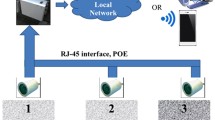Abstract
Since the 1973 discovery of the remains of the USS Monitor in 235 ft of water off Cape Hatteras, North Carolina, and its establishment in 1975 as the nation’s first National Marine Sanctuary, the site has been managed by the National Oceanic and Atmospheric Administration (NOAA). Under a federal management plan, which has as one of its overall goals the promotion and coordination of scientific research to expand our knowledge of this historically important cultural resource, the ironclad has been the subject of several research expeditions involving deep ocean technology (NOAA, 1983; Arnold et al., 1991). Remotely operated cameras, side-scan sonar, deep sea submersibles, submersibles utilizing lock-out divers, remotely operated vehicles, and other equipment have descended to the ocean bottom to make a record of the site (Arnold et al., 1991). These operations, although providing valuable information about the site, had limited access to the shipwreck (mostly its north side) because of prevailing currents and other weather

Artist’s conception of the USS Monitor site. By Rich Volz for the Farb Monitor Expedition.
conditions. In 1977 and 1979, during expeditions supported by the Harbor Branch Foundation, several scientists visited the site as lock-out divers tethered to a deep sea submersible (NOAA, 1983; Watts, 1979). With the discontinuation of lock-out dives following the 1979 expedition (NOAA, 1983), researchers have been allowed to work on the site only remotely via submersible, ROV, or data collection devices placed on the site. Researchers have not been able to do “hands-on” research on the site in over a decade. NOAA did not permit researchers to dive to the site using scuba equipment because of the extreme depth and for safety considerations. However, by late 1980s, advances in scuba equipment, dive computers, underwater lighting, and camera technology made diving and filming at depths equivalent to that of the Monitor commonplace among technical scuba divers. In 1990, after several years of consideration, NOAA allowed scuba divers to do limited research on the Monitor site for the first time.
Access this chapter
Tax calculation will be finalised at checkout
Purchases are for personal use only
Preview
Unable to display preview. Download preview PDF.
Similar content being viewed by others
References
Arnold, J.B., III, Eshman, G.M., Hill, D.B., Peterson, C.E., Steward, W.K., Gegg, S., Watts, G.P., Jr., and Weldon, C., 1991, The 1987 Expedition to the Monitor National Marine Sanctuary: Data Analysis and Final Report. Prepared for the Sanctuary and Resources Division: National Oceanic and Atmospheric Administration.
Molinari, F., and Preston, C., 1989, Frame Grabber Boards Acquire and Process Images in Real Time. Source Handbook, 8-3. Data Translation, Marlboro.
Muga, B.J., 1982, Engineering Investigation USS Monitor. North Carolina Department of Cultural Resources: Raleigh, and National Oceanic and Atmospheric Administration, 1983, USS Monitor National Marine Sanctuary. National Oceanic and Atmospheric Administration, Washington, DC.
Peterkin, E.W., 1985, Drawings of the USS Monitor: A catalog and technical analysis. USS Monitor, Historical Report Series, 1(1). North Carolina Department of Cultural Resources, Raleigh, and National Oceanic and Atmospheric Administration, Washington, DC.
Scheingold, D.H. (ed.), 1986, Analog Digital Conversion Handbook. Prentice-Hall: Englewood, Cliffs, NJ.
Stoltman, T., 1991, Video-Mosaic Imaging of the Alva Bradley. In Stem to Stern: Newsletter of the Program in Maritime History and Underwater Research 7(9): 11–12. East Carolina University, Greenville.
Tompkins, W., and Webster, J.G., 1988, Interfacing Sensors to the IBM-PC. Prentice-Hall, Investigating the Remains of the USS Monitor. A Final Report on 1979 Site Testing in the Monitor National Marine Sanctuary. North Carolina Department of Cultural Resources: Raleigh.
Editor information
Editors and Affiliations
Rights and permissions
Copyright information
© 1998 Springer Science+Business Media New York
About this chapter
Cite this chapter
Farb, R.M. (1998). Computer Video Image Digitization on the USS Monitor. In: Babits, L.E., Van Tilburg, H. (eds) Maritime Archaeology. The Springer Series in Underwater Archaeology. Springer, Boston, MA. https://doi.org/10.1007/978-1-4899-0084-5_42
Download citation
DOI: https://doi.org/10.1007/978-1-4899-0084-5_42
Publisher Name: Springer, Boston, MA
Print ISBN: 978-0-306-45331-1
Online ISBN: 978-1-4899-0084-5
eBook Packages: Springer Book Archive




